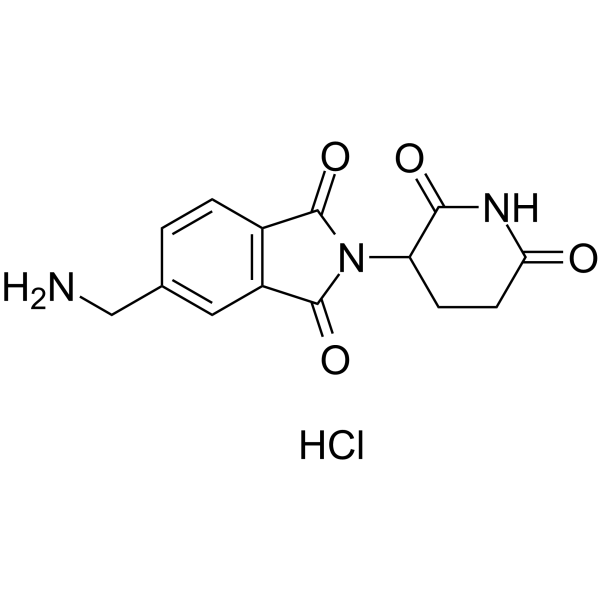Thalidomide-5-CH2-NH2 hydrochloride
Modify Date: 2025-08-28 00:10:50

Thalidomide-5-CH2-NH2 hydrochloride structure
|
Common Name | Thalidomide-5-CH2-NH2 hydrochloride | ||
|---|---|---|---|---|
| CAS Number | 1010100-22-7 | Molecular Weight | 323.73 | |
| Density | N/A | Boiling Point | N/A | |
| Molecular Formula | C14H14ClN3O4 | Melting Point | N/A | |
| MSDS | N/A | Flash Point | N/A | |
Use of Thalidomide-5-CH2-NH2 hydrochlorideThalidomide-5-CH2-NH2 (hydrochloride) is the Thalidomide-based cereblon ligand used in the recruitment of CRBN protein. Thalidomide-5-CH2-NH2 (hydrochloride) can be connected to the ligand for protein by a linker to form PROTACs[1]. |
| Name | 5-(Aminomethyl)-2-(2,6-dioxo-3-piperidinyl)-1H-isoindole-1,3(2H)-dione hydrochloride (1:1) |
|---|---|
| Synonym | More Synonyms |
| Description | Thalidomide-5-CH2-NH2 (hydrochloride) is the Thalidomide-based cereblon ligand used in the recruitment of CRBN protein. Thalidomide-5-CH2-NH2 (hydrochloride) can be connected to the ligand for protein by a linker to form PROTACs[1]. |
|---|---|
| Related Catalog | |
| Target |
Cereblon |
| In Vitro | PROTACs contain two different ligands connected by a linker; one is a ligand for an E3 ubiquitin ligase and the other is for the target protein. PROTACs exploit the intracellular ubiquitin-proteasome system to selectively degrade target proteins[2]. |
| References |
| Molecular Formula | C14H14ClN3O4 |
|---|---|
| Molecular Weight | 323.73 |
| Exact Mass | 323.067291 |
| InChIKey | ODZXEQVQLJKSQH-UHFFFAOYSA-N |
| SMILES | Cl.NCc1ccc2c(c1)C(=O)N(C1CCC(=O)NC1=O)C2=O |
| Hazard Codes | Xi |
|---|
| 5-(Aminomethyl)-2-(2,6-dioxo-3-piperidinyl)-1H-isoindole-1,3(2H)-dione hydrochloride (1:1) |
| MFCD32666042 |
| 1H-Isoindole-1,3(2H)-dione, 5-(aminomethyl)-2-(2,6-dioxo-3-piperidinyl)-, hydrochloride (1:1) |
| MFCD30188079 |